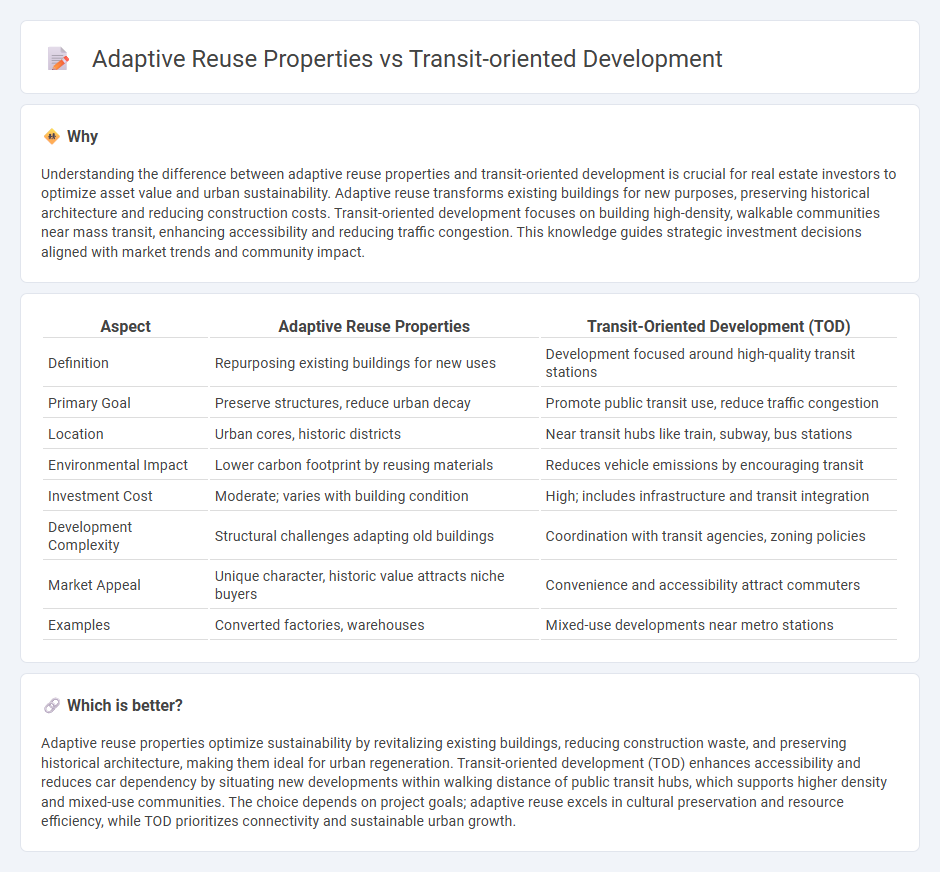
Adaptive reuse properties transform underutilized buildings into vibrant spaces, preserving architectural heritage while meeting modern needs. Transit-oriented development focuses on creating high-density, walkable communities centered around public transportation hubs, reducing car dependency and promoting sustainable urban growth. Discover the benefits and challenges of these real estate strategies to make informed investment decisions.
Why it is important
Understanding the difference between adaptive reuse properties and transit-oriented development is crucial for real estate investors to optimize asset value and urban sustainability. Adaptive reuse transforms existing buildings for new purposes, preserving historical architecture and reducing construction costs. Transit-oriented development focuses on building high-density, walkable communities near mass transit, enhancing accessibility and reducing traffic congestion. This knowledge guides strategic investment decisions aligned with market trends and community impact.
Comparison Table
| Aspect | Adaptive Reuse Properties | Transit-Oriented Development (TOD) |
|---|---|---|
| Definition | Repurposing existing buildings for new uses | Development focused around high-quality transit stations |
| Primary Goal | Preserve structures, reduce urban decay | Promote public transit use, reduce traffic congestion |
| Location | Urban cores, historic districts | Near transit hubs like train, subway, bus stations |
| Environmental Impact | Lower carbon footprint by reusing materials | Reduces vehicle emissions by encouraging transit |
| Investment Cost | Moderate; varies with building condition | High; includes infrastructure and transit integration |
| Development Complexity | Structural challenges adapting old buildings | Coordination with transit agencies, zoning policies |
| Market Appeal | Unique character, historic value attracts niche buyers | Convenience and accessibility attract commuters |
| Examples | Converted factories, warehouses | Mixed-use developments near metro stations |
Which is better?
Adaptive reuse properties optimize sustainability by revitalizing existing buildings, reducing construction waste, and preserving historical architecture, making them ideal for urban regeneration. Transit-oriented development (TOD) enhances accessibility and reduces car dependency by situating new developments within walking distance of public transit hubs, which supports higher density and mixed-use communities. The choice depends on project goals; adaptive reuse excels in cultural preservation and resource efficiency, while TOD prioritizes connectivity and sustainable urban growth.
Connection
Adaptive reuse properties enhance transit-oriented development by converting underutilized buildings near transit hubs into vibrant mixed-use spaces, increasing density and walkability. This synergy promotes sustainable urban growth, reduces car dependency, and maximizes land efficiency around transit stations. Leveraging adaptive reuse within transit-oriented developments supports economic revitalization and environmental benefits in metropolitan areas.
Key Terms
**Transit-oriented development:**
Transit-oriented development (TOD) strategically integrates residential, commercial, and recreational spaces within a walkable radius of public transit hubs to reduce car dependency and promote sustainable urban growth. This approach enhances property values, increases transit ridership, and supports vibrant, mixed-use communities with efficient land use. Explore how TOD transforms urban landscapes and drives economic and environmental benefits.
Mixed-use zoning
Transit-oriented development (TOD) leverages mixed-use zoning to create high-density, walkable communities centered around public transportation hubs, combining residential, commercial, and recreational spaces to reduce car dependency and enhance urban living. Adaptive reuse properties involve repurposing existing structures within mixed-use zones, preserving historical elements while integrating modern functionalities that support diverse community needs. Explore how these strategies optimize land use and urban sustainability in mixed-use zoning areas.
Walkability
Transit-oriented development (TOD) prioritizes walkability by integrating high-density residential and commercial spaces within a half-mile radius of public transit, enhancing pedestrian accessibility and reducing reliance on automobiles. Adaptive reuse properties improve walkability by repurposing existing structures in urban areas, often revitalizing neighborhoods and encouraging foot traffic through mixed-use designs. Explore more about how these approaches uniquely contribute to sustainable urban growth and walkable communities.
Source and External Links
Transforming the Urban Space Through Transit-Oriented Development - This article discusses transit-oriented development (TOD) as a strategy to create compact, mixed-use, pedestrian-friendly urban spaces around public transport stations.
Transit-Oriented Development | FTA - This webpage from the Federal Transit Administration explains how TOD promotes dense, walkable, mixed-use development near transit, fostering vibrant communities and economic growth.
What is TOD? - This resource from the Institute for Transportation and Development Policy describes TOD as integrated urban places that combine people, activities, and public spaces with efficient transit connections.
 dowidth.com
dowidth.com